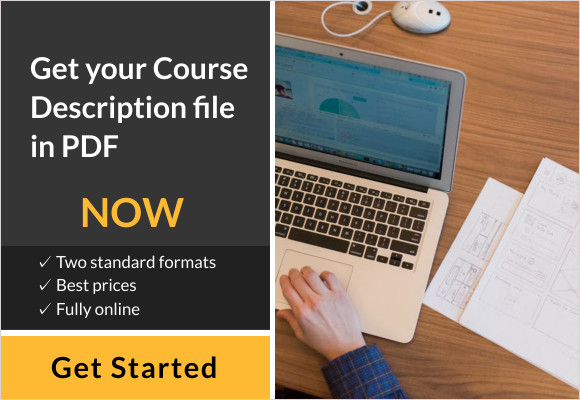Chapter 1: Understanding Digital Media Course Descriptions
Digital Media courses are designed to provide students with a comprehensive understanding of various aspects of digital content creation, management, and distribution. When examining a Digital Media course description, prospective students should look for several key components:
- Course Objectives: This section outlines the specific skills and knowledge that students will gain upon completion. For instance, a course might aim to equip students with the ability to design effective digital marketing strategies or create engaging multimedia content.
- Curriculum Overview: A well-structured course description should include an overview of the topics covered. Essential subjects might include digital storytelling, social media strategies, graphic design principles, and video production techniques, which are critical for a foundational understanding of the field.
- Prerequisites: Understanding any necessary prerequisites is vital for students. Some programs may require prior knowledge in basic media production or graphic design, while others might be open to beginners.
- Target Audience: Effective descriptions often specify who will benefit most from the course. This may include aspiring digital marketers, content creators, or those looking to enhance their skills for career advancement in the ever-evolving digital landscape.
- Outcome and Career Pathways: Finally, students should consider the potential career pathways highlighted in the course description. This may include roles such as digital media specialist, content strategist, or social media manager, guiding students in aligning their educational pursuits with their career goals.
For those interested in obtaining accurate and official Digital Media course descriptions, Course-Description.com serves as a valuable resource, providing a centralized platform for generating and downloading these essential documents.
Chapter 2: How to Create or Customize Your Course Syllabi
Creating a comprehensive syllabus for a Digital Media course involves several key steps to ensure it meets both academic standards and your educational objectives. Here’s a straightforward guide to assist you in this process:
- Define Course Objectives: Clearly outline what you aim to achieve by the end of the course. This may include developing critical thinking skills, enhancing digital literacy, or understanding media production processes. Reference educational resources to align your objectives with industry standards.
- Establish Course Structure: Break down the course into modules or units. Each section should cover specific topics, such as digital storytelling, multimedia design, and social media analysis. A well-structured syllabus helps students navigate the content systematically.
- Select Required Materials: Choose textbooks, articles, and online resources essential for your course. Resources such as Digital Media Fundamentals and The Media Student’s Book can provide foundational knowledge. Include links to digital materials to facilitate access.
- Incorporate Assessment Methods: Outline how you will evaluate students’ progress through quizzes, project submissions, peer reviews, and participation. Clearly communicate expectations in the syllabus to minimize misunderstandings around grading.
- Establish Policies: Articulate your class policies regarding attendance, late submissions, and academic integrity. These guidelines set the tone for the class and ensure that students understand the importance of professionalism in the digital media field.
- Include a Schedule: Provide a week-by-week schedule outlining topics, assignment due dates, and exam periods. A detailed timeline helps students manage their study plans effectively.
- Utilize Templates: Consider using templates available through services like Course-Description.com for a professional format. These templates can be customized to fit the specific needs of your course while adhering to academic standards.
- Gather Feedback: After your syllabus is drafted, seek feedback from colleagues or academic advisors. Insights from others can enhance clarity and comprehensiveness.
- Revise and Finalize: Use the feedback to make necessary adjustments, ensuring your syllabus is clear, engaging, and aligns with your educational objectives.
Chapter 3: Accessing and Downloading Course Resources in PDF Format
To access and download course descriptions and syllabi in PDF format, start by visiting Course-Description.com. The site offers a user-friendly interface that allows you to search for your desired course titles or codes quickly.
Signing Up for Free Access
- Create an Account: Navigate to the ‘Sign Up’ section and provide the required information such as your name and email address. This step is crucial as it allows you to track your downloaded resources.
- Email Verification: After registering, check your email for a verification link. Click the link to activate your account, ensuring you have full access to all features.
Finding Course Resources
- Search Functionality: Use the search bar to type in the course name or code. The platform will generate a list of relevant course descriptions and syllabi that meet your criteria.
- Filter Options: Utilize the provided filters to narrow your search by category, institution, or degree level. This can save valuable time, especially when dealing with vast amounts of data.
Downloading PDF Files
- Select Your Course: Once you find a relevant course, click on it to view more details.
- Download Button: Look for the download button prominently displayed on the course page. By clicking this, the PDF file will automatically download to your device.
- Access Your Downloads: Ensure that you have a PDF viewer installed on your device to open and review your downloaded course materials easily.
For detailed instructions and assistance, explore the help section on Course-Description.com or consult their FAQ page, which provides valuable information about account management and troubleshooting.
Conclusion
Well-prepared course descriptions are essential for any educational journey, especially in the dynamic field of Digital Media. They serve as a roadmap, guiding students through their academic experience by providing clear insights into course objectives, outcomes, and requirements. This clarity helps prospective learners make informed decisions about their educational pathways, ensuring they select courses that align with their career goals and interests.
Moreover, well-structured course descriptions can enhance student engagement and motivation. When students understand what to expect and how each course ties into broader learning outcomes, they are more likely to invest in their education and seek deeper engagement with the material. This aligns with best practices in curriculum development, emphasizing transparency and student-centered learning.
For educators and institutions, investing time and resources into crafting comprehensive course descriptions is equally important. Not only do they attract potential students, but they also facilitate smoother program administration and curriculum alignment.
To ensure your course descriptions are top-notch, consider utilizing resources from Course-Description.com, where you can generate and download official course descriptions tailored to your specific needs.










